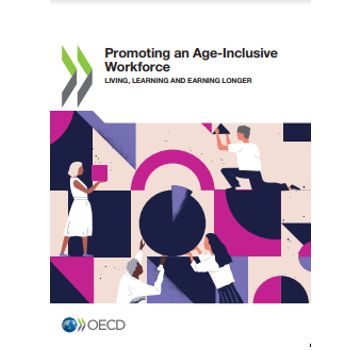
Promoting an Age-inclusive Workforce. Living, Learning and Earning Longer
OECD
Promoting an Age-inclusive Workforce. Living, Learning and Earning Longer
OECD, December 2020, 156 pages
Scaricabile liberamente su
https://www.oecd-ilibrary.org/employment/promoting-an-age-inclusive-workforce_59752153-en
Tutte le economie dell'OECD stanno subendo un rapido invecchiamento della popolazione, con la conseguenza di avere un numero maggiore, rispetto al passato,
di fasce di età nei luoghi di lavoro, poiché le persone non solo vivono più a lungo, ma lavorano più a lungo.
I datori di lavoro hanno così a disposizione più esperienze, più competenze e più talenti che consentono loro di migliorare la produttività e la redditività.
Il Rapporto affronta il tema della compresenza di più fasce di età sul posto di lavoro e sfata diversi pregiudizi sulle differenze tra lavoratori giovani e meno giovani riguardo alle performance e agli atteggiamenti e le motivazioni nei confronti del lavoro.
Cosa possono fare gli imprenditori per massimizzare i vantaggi di una forza lavoro multi-generazionale?
Proponendo la progettazione e la realizzazione di politiche per tutte le età e le fasi della vita, e quindi in grado di coprire l'intera durata della carriera di ogni lavoratore, il documento presenta iniziative ed esempi pratici in tre aree che si rivelano importanti al fine di sostenere e promuovere una forza lavoro age-inclusive: le best practices in materia di reclutamento, retention e pensionamento, la promozione del long-life learning e la salvaguardia della salute sul lavoro.


Foreword
By 2050, more than four in ten individuals in the world’s most advanced economies are likely to be older than 50.
The workforce is ageing even more rapidly as smaller cohorts of younger people enter work at a later age and older people are staying on longer at work.
Inherently, both business and economic success and productivity will be increasingly tied to that of older workers.
If employers and other key stakeholders are to adapt to ongoing changes in the world of work – now accelerated by the COVID-19 pandemic – they will need to re-evaluate their policies and practices with an eye toward an age-inclusive workforce.
The demographic trends are working in favour of multigenerational workplaces with a greater mix of workers at all ages rather than a pyramid of much larger numbers of younger workers and relatively few older workers.
However, rather than being age-blind, both public employment and retirement policies and corporate practices are often closely tied to the age of workers rather than to their actual work capacity and individual needs.
Thus, despite older adults now being healthier and better educated than ever before, their talent often remains underutilised and overlooked. This will have to be turned around.
Corporate executives increasingly understand and value age diversity. According to a 2020 global survey of corporate executives undertaken by AARP in 36 OECD countries, 83% reported that a multigenerational workforce was valuable to their organisation’s success and growth.
Nevertheless, many employers are struggling to establish effective policies that continue to support workers’ living, learning and earning at older ages.
The same survey revealed that fewer than 5% of employers have put concrete polices in place such as unbiased recruiting processes, phased retirement or return-to-work programmes to recruit and retain an age-diverse workforce.
Part of this inaction is fuelled by widespread misconceptions about the strengths and capabilities that different generations bring to the workplace.
This report debunks several myths and demonstrates the positive impact of age diversity and inclusion on a firm’s long-term competitive growth and organisational resilience.
It builds on a unique collaboration between OECD, AARP and the World Economic Forum, which has engaged more than 50 global employers – representing over 2 million employees and USD 1 trillion in annual revenue.
The report presents evidence on promising approaches, practical examples and ideas for successful multigenerational workplaces and provides a checklist on what employers can do to support and sustain age-friendly workplaces.
Findings in this report complement a digital learning platform for employers to recognise the benefits of an age-inclusive workforce as an untapped source of growth.
Ultimately, workplace policies and practices cannot be implemented in isolation for specific groups at specific times in their careers – it is not about targeting one age group at the perceived expense of another.
Employers will only succeed if they develop initiatives in the context of nurturing an age-diverse workplace and taking a life-cycle perspective with supportive public policies and good social dialogue.
Doing so, will benefit all of us as well as future generations in terms of greater prosperity and well-being.
Stefano Scarpetta, Director of Employment, Labour and Social Affairs - OECD
Recensione a cura di Elisabetta Crolla Gianolio
Tratto da "Panorama Risorse Umane" - Documentazione e notizie su Sviluppo e Gestione delle Persone - Uno dei servizi dell'Abbonamento ISPER





